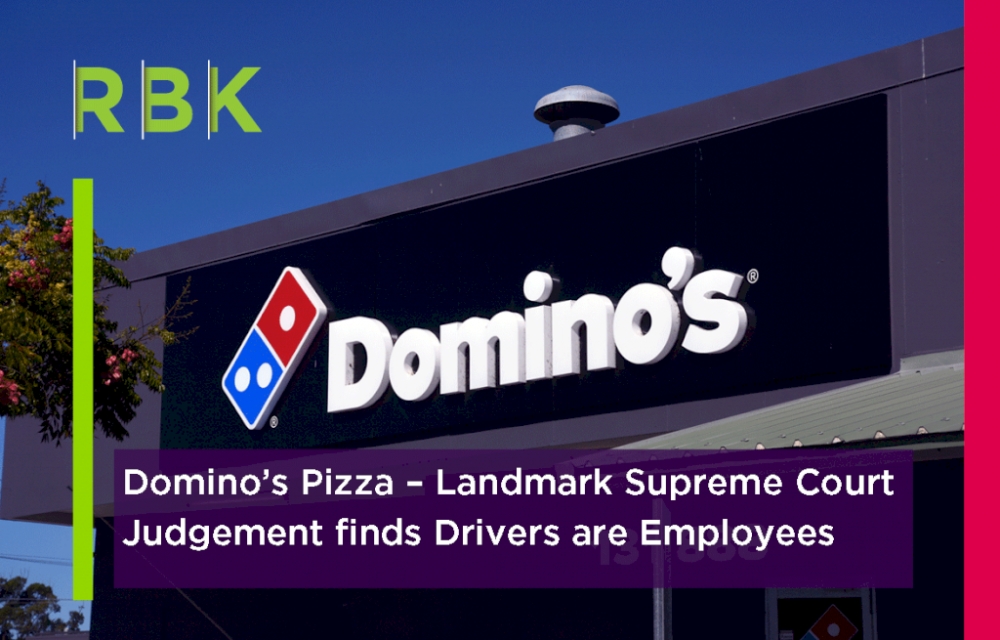Background
On the 20 October 2023 the Supreme Court delivered a landmark judgement in the case of The Revenue Commissioners v Karshan (Midlands) Ltd T/A Domino’s pizza. The case was a tax case relating to the tax status of delivery drivers engaged by Karshan. Karshan had treated the drivers as self-employed contractors. Revenue had challenged this position and argued that the drivers were in fact employees and were not self-employed. Karshan appealed against the Revenue’s assessment to the Tax Appeals Commissioner (TAC). The TAC held in favour of the Revenue. A further appeal was taken to the High Court, which upheld the TAC determination (in favour of the Revenue). The High Court decision was appealed to the Court of Appeal which found in favour of the taxpayer, overturning the decision of the High Court. Revenue appealed against the Court of Appeal decision to the Supreme Court which has overturned the Court of Appeal decision and has upheld the decision of the TAC, in effect finding that the drivers were in fact employees and were not self-employed.
The question of whether or not an individual is providing services under a contract for services (self-employed) or a contract of services (employee) has been around for years. Where an employment relationship exists, Irish tax legislation provides that the employer is required to operate payroll taxes and pay social security. Where the individual is self-employed, the obligation to correctly remit taxes falls on the self-employed individual. The issue that arises is that whilst Irish tax legislation is clear that employers must operate payroll taxes, there is no guidance in Irish tax legislation as to how to determine whether or not an individual is an employee. Justice Murray in the Supreme Court referred to this in his decision stating, in respect of the Irish tax legislation, that “ None of these provisions afford any guidance as to how the question of whether in any given case a worker is or is not an employee, should be resolved”. Because there has been no legislative definition of what constitutes an employment relationship, it has been necessary to rely on tests established in caselaw. This has tended to leave a lot of “grey” areas which has led to uncertainty for businesses. This has been exacerbated when one considers that work practices have evolved significantly over the years. The concept of a 9 to 5 salary job physically based in the employer’s premises is much less prevalent now.
Decision
The Supreme Court decision goes into considerable detail in reviewing and analysing caselaw, in Ireland and in other common law jurisdictions. A lot of the caselaw had focused on the concept of “mutuality of obligations”. Justice Murrary remarked that “Much of the difficulty in this appeal arose from various different meanings applied by the case law, commentators, the parties, the Commissioner, the High Court and the Court of Appeal judges to the term ‘mutuality of obligation’” . Justice Murray having considered relevant caselaw on the concept of ‘mutuality of obligations’ went on to say that “the term ‘mutual obligations’ when used in this context has generated unnecessary confusion. This, I think, will be most effectively avoided in the future if the use of the phrase in this arena is discontinued”.
In finding that the drivers were employees for tax purposes, Justice Murray went on to set out a test for determining whether a contract is one “of service” or “for service”, which is set out below:
- Does the contract involve the exchange of wage or other remuneration for work?
- Has the worker agreed to provide their services to the employer personally?
- If so, does the employer exercise sufficient control over the putative employee to render the agreement one that is capable of being an employment agreement?
- If these three requirements are met the decision maker must then determine whether the terms of the contract between employer and worker interpreted in the light of the admissible factual matrix and having regard to the working arrangements between the parties as disclosed by the evidence, are consistent with a contract of employment, or with some other form of contract having regard, in particular, to whether the arrangements point to the putative employee working for themselves or for the putative employer.
- Finally, it should be determined whether there is anything in the particular legislative regime under consideration that requires the court to adjust or supplement any of the foregoing.
The above is very important as the Supreme Court has effectively determined that mutuality of obligation is not a pre-requisite for the finding of an employment relationship.
Relevance of the Decision
The Supreme Court decision is a very important and highly significant decision. Following on from the Supreme Court decision, Revenue quickly published an update stating that “any business which currently engages contractors, sub-contractors or other workers on a self employment basis (i.e. where that worker is not treated as an employee of the business- for income tax purposes), should review the nature of any such arrangement(s)” . Following on from the Supreme Court decision it is likely that we will see a focus from Revenue in the coming year on the appropriate classification of individuals as self-employed. It is important to note at the outset that it is not possible to contract out of an employment relationship by simply including a provision in the contract that the individual is not an employee or that they will be responsible for the taxes arising. What is clear and has been reinforced by the Supreme Court decision is that an employment relationship can exist based on the facts and circumstances regardless of what the contract says. Every case needs to be considered in light of the test laid down by the Supreme Court.
We would strongly recommend that businesses review their current arrangements and contracts in light of the Supreme Court decision and in particular the test laid down by the Supreme Court. Businesses need to be aware that where they are engaging contractors on a self employed basis, if Revenue were to successfully challenge the treatment that the obligation to account for taxes and PRSI falls on them. It is also very important that businesses are aware that if individuals are deemed to be employees for tax purposes, this can also have wide ramifications from an employment law perspective such as entitlement to contracts of employment, statutory leave, holiday pay, employment rights etc. The Supreme Court expressly stated that this decision was relevant for the purposes of the Taxes Consolidation Act and that it was not necessarily relevant for other purposes in particular employment rights legislation. However it is difficult to square this circle and businesses would be well advised to be aware of the risks including potential employment law claims.
Contact Us:
Should you wish to discuss any aspect regarding an individual’s employment status or potential implications of this case, please contact a member of our Tax or HR Solutions Team:
- Ronan McGivern , Tax Partner: +353 1 6440100
- Yvonne Clarke , HR Solutions Manager: + 353 90 6480600



